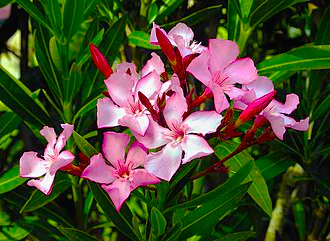Context
Two Kerala government-run temple boards, responsible for 2,500 temples, have stopped using oleander flowers in offerings.
- This decision has been taken after a 24-year-old woman died from chewing oleander leaves accidentally.

About Oleander flowers
- Nerium oleander is commonly known as oleander or rosebay.
- Other name: In Kerala, the plant is known by the names of arali and kanaveeram
- This plant is cultivated worldwide in tropical, subtropical, and temperate regions.
- Different oleander varieties have flowers of various colors.
- Medicinal Use : In proper doses, it can strengthen and speed up heart contractions.
- Features
- Unique feature: It is well Known for its drought tolerance feature.
Enroll now for UPSC Online Course
Traditional medicine
API (Ayurvedic Pharmacopoeia of India) mentions oleander root bark oil for skin diseases.
-
- The plant has been “frequently described in Brihattrayi, Nighantus and other classical Ayurvedic texts.
- Charak Samhita: White flowered oleander leaves are prescribed externally for chronic and severe skin diseases, including leprosy.
- Bhavaprakasha: Describes oleander as “visha” (poison) but also indicates its use for:
- Vrana (infected wounds)
- Kustha (skin diseases including leprosy)
- Krimi (microbes and parasites)
- Kandu (itching)
Reason for Oleander’s toxicity:
- The reason for oleander’s toxicity is due to the presence of cardiac glycosides throughout the plant. These chemicals, including oleandrin, folinerin, and digitoxigenin, have strong effects on the heart.
- Cardiac glycosides:These are steroidal compounds that can impact heart muscle function.
Also Read: Why Are Heart Attacks Becoming Common Among The Youth?
![]() 12 May 2024
12 May 2024

